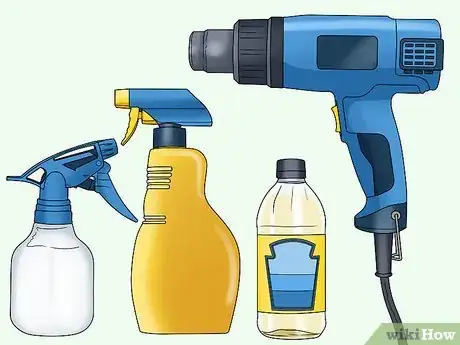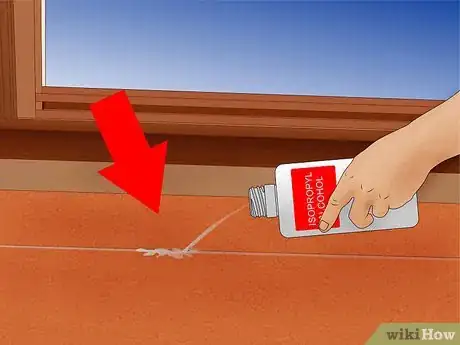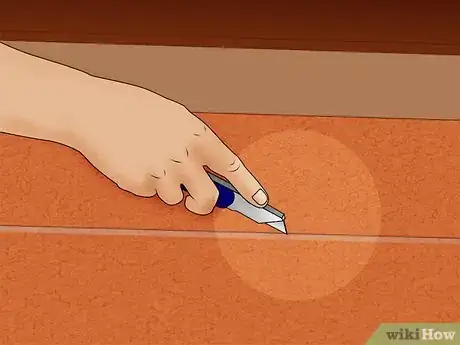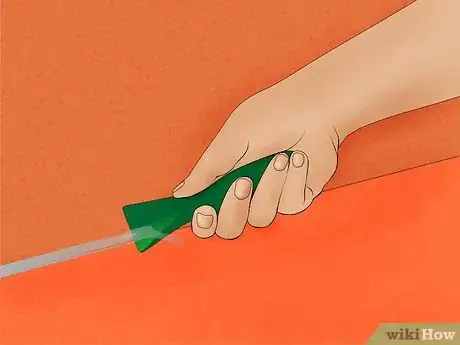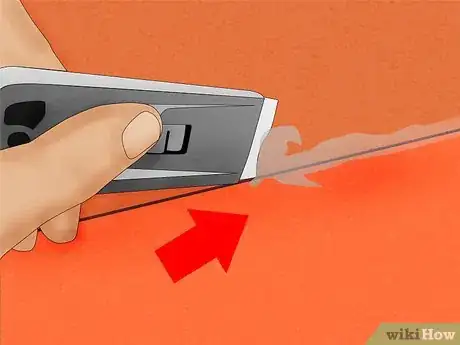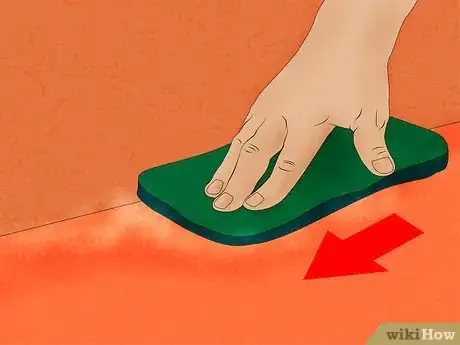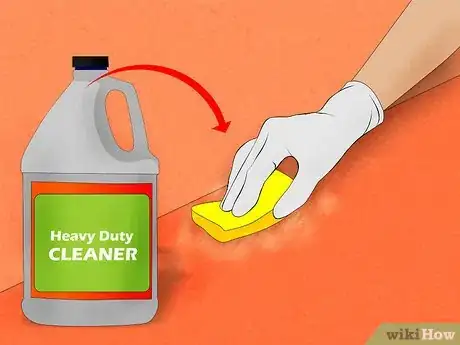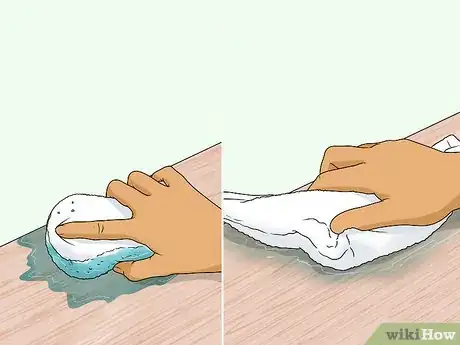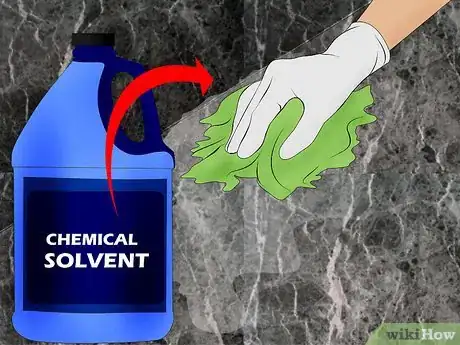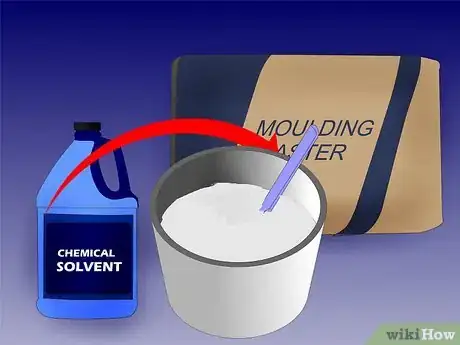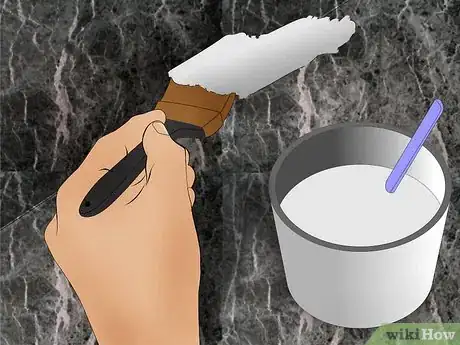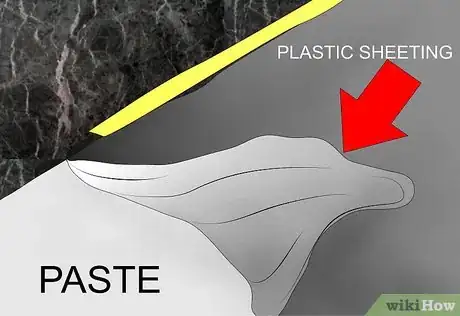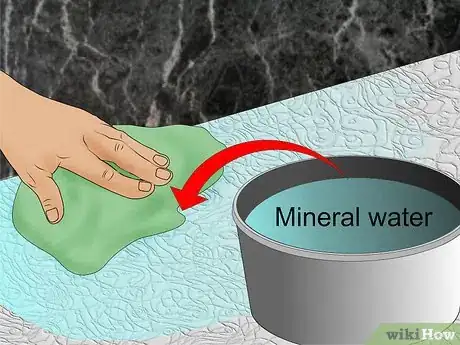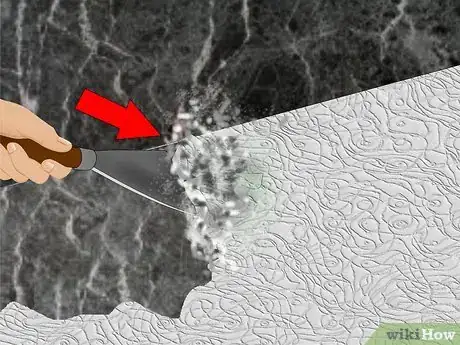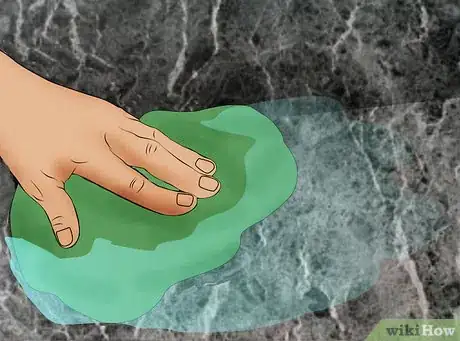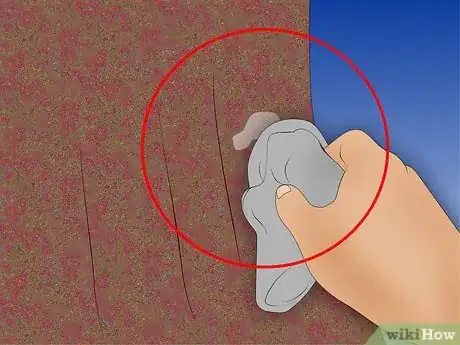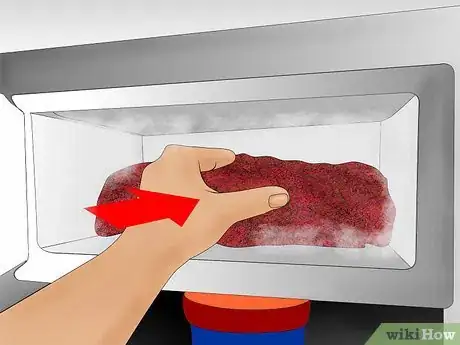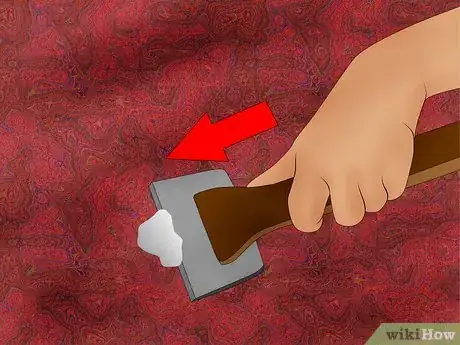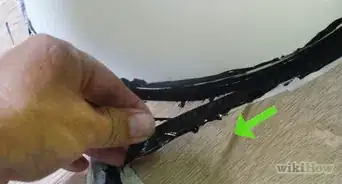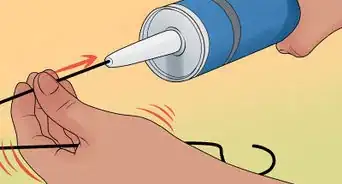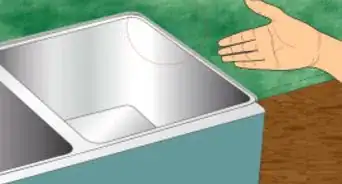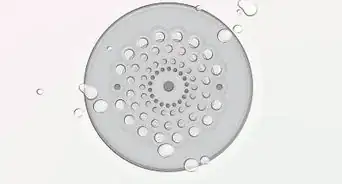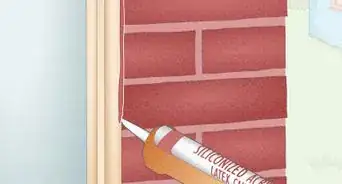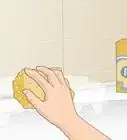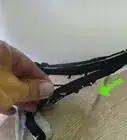This article was co-authored by Emily Fazio and by wikiHow staff writer, Hannah Madden. Emily Fazio is a Home Improvement and DIY Specialist and the author behind Merrypad, a home improvement and DIY lifestyle blog. Emily develops content for Discovery including HGTV.com and DIYNetwork.com, among other influential interior design and homesteading websites. Her partnerships include companies such as Legrand, Sherwin-Williams, Stihl, and Kohler. Emily studied at St. Bonaventure University.
This article has been viewed 419,520 times.
When caulk has lost its effectiveness, it needs to be replaced. Before you can apply new caulk, though, you'll need to remove the old stuff. Some of the principles used in removing caulk can also be used to remove caulk stains. Keep reading to learn more about these techniques.
Steps
Removing Caulk
-
1Soften the caulk with chemicals or heat. Fresh caulk can usually be removed without softening it, but older caulk that has fully hardened may need to be softened first in order to make it pliable enough to remove. You can usually do this with water, vinegar, chemicals, or heat, depending on the type of caulk.
- Commercial caulk remover is the simplest choice and may be your best option for silicone caulk. Apply the caulk remover by squeezing a wide bead along the caulk line, completely covering it from end to end. Let it sit for several hours as directed on the label.[1]
- If you are dealing with non-acrylic water-based caulk, you can soak the caulk with saturated rags for 72 hours to soften the caulk effectively.
- If dealing with water-based acrylic caulks or polyvinyl acetate resins, soak the caulk by dampening it with iso-propyl rubbing alcohol.[2]
- To use heat on any form of caulk, apply heat from a hair dryer on the lowest setting for 30 to 40 seconds. Work in patches of about 8 inches (20 cm) at a time.[3]
-
2Slice through the caulk with a blade. Use a small razor blade to cut through each end bead of caulk, exposing the edge of the line.
- Alternatively, you can slice from end to end, spanning the full length of the caulk and cutting the line completely in half. Doing so can free up more edge and may even cause some of the caulk to fall out on its own.
Advertisement -
3Pull the caulk out by hand. Grab the exposed edge of the caulk with your fingers and pull out as much as possible. Pull toward the direction of the remaining line of caulk to lift it out.
- If you cut along the full length of the caulk line, peel up the line starting on one end and pull in the direction opposite that end to remove as much as possible.
-
4Scrape out the remaining caulk. Use a glass scraper to scrap out any remaining, visible caulk. Hold the scraper at a shallow angle, keeping it as flat as possible, to avoid scratching the surface.
- You could also use a putty knife, plastic razor blade, or another similar tool.[4] Keep in mind that the tool you use should have a fairly flat “blade” with a somewhat dull edge. You do not need to cut more of the caulk out with this tool; you only need the tool for the sake of scraping away caulk from underneath.
-
5Pull caulk out of deep crevices with needle-nose pliers. If you cannot reach some of the caulk with your scraper, use needle-nose pliers to pick and pull out any visible chunks.
- Needle-nose pliers are preferable to other types of pliers since they tend to be narrower and are easier to maneuver in and out of small crevices.
-
6Rake out remaining chunks of caulk. Use the hook end of a painter's five-in-one tool to scrape out any remaining caulk debris from the crevice.[5]
- Scrape in one direction, pulling as much of the caulk away and out as possible. Hopefully, you should be able to get rid of the rest of the chunks after completing this step.
Removing Moldy Caulk Residue
-
1Scrub the surface with an abrasive pad. Soak the abrasive pad in mineral water or mineral spirits before scrubbing with firm, even force along the surface from which the old caulk had been removed.
- Rubbing the surface down with mineral spirits strips away any remaining caulk residue. Residue can prevent new caulk from sticking. Moreover, if there is mildew or mold caught in that residue, it poses a health hazard if it is not removed.
-
2Wash the surface with a non-ammoniated bath cleaner. Clean away soap scum by thoroughly scrubbing the surface with a cleaner and sponge.
- Do not use ammonia or a cleaner that contains ammonia. You will be using bleach in the next step, and when combined, bleach and ammonia can create toxic fumes.
-
3Wash with a diluted bleach solution. Combine 1/3 cup (80 ml) bleach with 1 gallon (4 L) of water until well mixed. Apply this solution to the gap from which the caulk was removed.
- Use paintbrush or foam brush too apply the bleach solution.
- Let the solution sit on the caulk for about five minutes before disturbing it.
- Scrub the bleach away with a toothbrush or firm plastic pad.
-
4Rinse and let dry. Rinse the area with warm water and pat the surface and the gap with a clean, dry rag.
- At this point, you can and should apply new caulk. Make sure that the surface is completely dry before doing so, however, since caulk may not adhere to wet surfaces.
Removing Silicone Caulk Stains from Hard Surfaces
-
1Rinse the area with mineral water. Before applying any chemical solvent to a caulk stain on marble or any other hard surface, rinse the area with mineral water or distilled water to remove any residue.
-
2Moisten the stain with a chemical solvent. Choose a chemical solvent noted for effectiveness against silicone caulk. Dampen the stained area using a clean rag.
- Note that you only need to use heavy solvents on silicone caulk stains. Other types of caulk stains, like acrylic and non-acrylic caulks, are less stubborn and can usually be removed with nothing but water and physical scraping.
- Common, effective chemicals include Methylene Chloride, Dichloromethane, Methylene Bichloride, and Methylene Dichloride.
-
3Mix the solvent with a white absorbent material. Combine additional solvent with enough white absorbent material to form a thick paste.
- Possible absorbent material options include molding plaster, untreated white flour, white tissue, white paper towels, powdered chalk, talc, fullers earth, or laundry whiting.
- Note that you'll need about 1 lb (450 g) of paste for every square foot (30.5 square cm).
-
4Apply the paste to the stain. Layer the paste on the caulk stain using a plastic or wooden spatula. Make sure that the paste is 1/4 inch (6.35 mm) thick or less.
- This paste should cover the entire stain and extend a bit past the edges. If you do not let the paste extend past the stain, the stain could end up being forced onto clean patches of stone.
- After applying the paste, make sure that the coating is free of any air pockets.
-
5Let the paste set. Cover the paste with plastic sheeting and seal the edges off with masking tape. Let it set for 48 hours undisturbed.
- If using a solvent with other instructions, however, follow the instructions provided on the solvent label.
-
6Dampen the area with mineral water. Doing so softens the hardened paste enough to help lift it off.
-
7Scrape away the dried paste and caulk. Use a wooden or plastic spatula to gently scrape away the paste and the loosened caulk.
- Do not use anything harder since many hard surfaces, like marble, can get scratched up as a result.
-
8Rinse with mineral water. Rinse the area once more with mineral water or distilled water to remove any residue. Blot dry with clean paper towels.
- You might need to apply this treatment multiple times before all the caulk comes up. You can do so once the surface is completely dry.
Removing Caulk Stains from Cloth
-
1Wipe off as much of the caulk as possible. If you catch the stain as soon as the caulk gets onto the material, you might be able to wipe most of it off with a clean, damp rag.
- Gently rub at the stain. As you rub, use a slight upward motion to encourage the caulk to come off the material instead of rubbing it further into the fibers.
- You could attempt to simply dab at the stain, but this may not be enough force depending on how much the caulk has already begun to set.
- Use warm water instead of cold water since warmth encourages the caulk to stay soft.
-
2Freeze the material, if possible. If the caulk got on your clothes or some other removable item of fabric, place the stained item in the freezer for 30 to 60 minutes or until well frozen.
- You do not, of course, need to do this step or any of the following steps if the caulk came off simply by scrubbing it.
- When ready, the fabric should be very stiff and the caulk should be hard to the touch.
-
3Scrape or peel the hardened caulk off. The solidified caulk should be easier to remove. You can scrape at it with a painter's chisel until the strip of caulk begins to peel up, then peel the rest away with your fingers.
- It is not recommended for you to chisel or scrape away the entire caulk stain. Doing so could cause the fibers in the material to tear more than necessary.
-
4Apply an acetone-based cleaner.[6] If some of the caulk stain still remains, you can apply a small amount of an acetone-based cleaner directly to the stain before dabbing it out.
- Before using the acetone, test it on a small part of the material hidden along the underside. Acetone can fade and ruin certain fabrics, so testing it is necessary if you do not want to risk further damage.
- Apply the cleaner to the fabric using a cotton swab or cotton ball. Let it sit for five minutes or as directed on the label before rinsing out with warm water.
- Launder the cloth as usual when done.
Community Q&A
-
QuestionHow can I remove silicone caulk dropped and then wiped across my window screen?
 wikiHow Staff EditorThis answer was written by one of our trained team of researchers who validated it for accuracy and comprehensiveness.
wikiHow Staff EditorThis answer was written by one of our trained team of researchers who validated it for accuracy and comprehensiveness.
Staff Answer wikiHow Staff EditorStaff AnswerTry spreading a thin layer of silicone solvent on the caulk and letting it sit for a few hours. Then, take a sponge and gently rub the caulk off of the screen. Use a hose and spray it with water to get any excess caulk out of the screen.
wikiHow Staff EditorStaff AnswerTry spreading a thin layer of silicone solvent on the caulk and letting it sit for a few hours. Then, take a sponge and gently rub the caulk off of the screen. Use a hose and spray it with water to get any excess caulk out of the screen. -
QuestionWhat is mineral water?
 Community AnswerWater that contains some minerals, such as salts. If you're looking for it at a store, it will be clearly labeled "mineral water."
Community AnswerWater that contains some minerals, such as salts. If you're looking for it at a store, it will be clearly labeled "mineral water." -
QuestionHow do I remove silicone caulking applied to a wood surface to stick ceramic tiles? The ceramic tiles have been removed, but the silicone is very much still there.
 Community AnswerAcetone is a possible solution, but be careful of the fumes. Also use a good scraper.
Community AnswerAcetone is a possible solution, but be careful of the fumes. Also use a good scraper.
Things You'll Need
- Commercial caulk remover
- Mineral water
- Clean rags
- Iso-propyl rubbing alcohol
- Hair dryer
- Razor blade
- Glass scraper
- Needle-nose pliers
- Painter's five-in-one tool
- Abrasive pad
- Non-ammoniated bath cleaner
- Bleach
- Wooden or plastic spatula
- Paintbrush
- Bucket
- White absorbent material
- Caulk-removing chemical solvent
- Plastic sheeting
- Masking tape
- Paper towels
- Freezer
References
- ↑ http://www.familyhandyman.com/tiling/how-to-remove-caulk-easily/view-all#step1
- ↑ http://www.askthebuilder.com/caulk-removal/
- ↑ http://www.homerepairtutor.com/easily-remove-silicone-caulk/
- ↑ Emily Fazio. Home Improvement & DIY Specialist. Expert Interview. 27 July 2021.
- ↑ http://www.popularmechanics.com/home/improvement/interior/4213124
- ↑ http://www.youtube.com/watch?v=o0BMXqbuZwM
About This Article
To remove old caulk, soften it first so it's easier to remove. You can apply a commercial caulk remover or soak the caulk with water-saturated rags for 72 hours. Once the caulk has softened, use a small razor blade to slice through it and create exposed edges, making it easier to remove. Next, pull out as much caulk by hand as you can and scrape away any remaining caulk using a glass scraper. If you need to remove moldy caulk residue, soak an abrasive pad in mineral water and scrub the residue away. Then, use a non-ammoniated bath cleaner to clean away any soap scum. For more information on removing caulk, like how to remove caulk from a cloth, read on!
